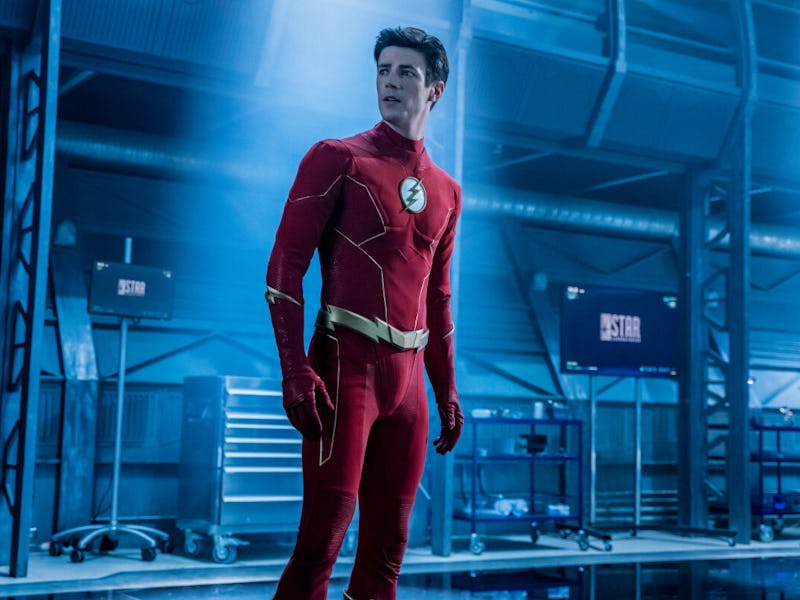The Flash TV Show Did One Thing Better Than Marvel Ever Could
An ode to how The Flash ran circles around the rest.

To understand what I’m about to tell you, you need to believe in the impossible: That weekly, episodic TV is still a valuable form of entertainment.
With The CW’s The Flash now past the finish line, its finale not only marks the conclusion of the story of scientist-turned-superhero Barry Allen (played by Grant Gustin for all nine seasons) but the end of an era for superhero pop culture.
As the Arrowverse has winded down, there’s been plenty said about how the franchise fostered fandom culture between Marvel and DCEU releases. The Flash is also overdue for recognition in popularizing the multiverse. But if there’s one more thing The Flash ought to be memorialized, its how it made maximal use of traditional TV in ways that lived up to its comic book origins.
Whereas Marvel and even DC have now fully pivoted to the streaming model — DC made a spinoff show of one of its own movies, even! — The Flash authentically lived up to its comic book roots as an episodic show with a Buffy-esque monster of the week format. And it did so without shame.
While it wasn’t perfect all the time, The Flash was undoubtedly phenomenal as a superhero show that relished its traditonal TV structure.
Of all the superhero shows in the modern era, including the transgressive The Boys, the woefully overlooked Black Lightning, and the zany, queer Legends of Tomorrow, The Flash truly emulated the feeling of picking up a comic book and watching it unfold on the screen. That’s a specific science too many new superhero shows are disinterested in doing, instead preferring to satirize the genre or subvert expectations — or in Marvel’s case, continue its synergy with the movies. As streaming continues to eclipse so much visual entertainment, episodic TV may be on the brink of extinction ... and The Flash may be one of its last hurrahs.
To be clear, there had been other superhero shows before The Flash that also adhered to weekly formats. It spun from Arrow after all, itself a show that came off the heels of the 10-season strong Smallville. Marvel embarked on episodic TV with Agents of S.H.I.E.L.D. a full year before The Flash aired. Even now The CW still has shows for the foreseeable future, two of them DC (Gotham Knights and Superman & Lois, which are officially still on the air, even if their cancellations are looming).
But there’s meaningful symbolism in The Flash feeling like the end for so many things at once: for The CW as we know it, for the dominant “Arrowverse,” and for the weekly TV model that best suited the genre. The Arrowverse wholly typified the highs and lows of episodic TV for superheroes, from its unserious atmosphere to its organic evolution of characters in ways only TV can offer. Happy accidents is what makes TV the fluid and free-wheeling medium than the comparatively more rigid movies, and even streaming TV’s “eight-hour movies.”
Of the many things The Flash did right, it was its guest stars that resurrected a forgotten art. Remember Mark Hamill and John Wesley Shipp living out their glory days from their own 1990 TV series?
It’s because of its flexibility that The Flash grew to become one of the better shows at the apex of The CW. While it never forsook the soap opera cheese that defined the network, The Flash could be — and often was — many things at so many times. It was a superhero drama, but it was also a time-traveling sci-fi, a young adult romance, and for at least one episode, a musical. Such a format also invited guest stars, a forgotten art in TV. The likes of David Dastmalchian, Mark Hamill, Danny Trejo, and Tom Felton were on The Flash, not to mention John Wesley Shipp allowed meaningful closure from his own 1990 series. Even the soon-to-release movie The Flash seems fine-tuned to such a specific wavelength that is impossible to see it as jovially experimental as its older TV cousin.
The Flash was far from perfect. It was bad timing that its wobbly fourth season in 2018, which began a creative funk the show never shook off, coincided with streaming’s amassing power. That same year when The Flash’s war with the Thinker brought the show its first screeching halt, Disney acquired Fox for the sole purpose of beefing up its streaming efforts. That was also when Warner Bros. launched DC Universe (later absorbed into what is now Max), showing how committed even DC was to this brave new world.
Despite an altogether strong start where it seemed to fire on all cylinders, The Flash just as quickly began spinning its wheels. It had the misfortune of being locked into its nature as a 20-plus episode per season production when that format wasn’t en vogue. Now when streaming fosters its own fatigue, there’s something precious about the old ways. At least once upon a time, The Flash ran circles around everything else, and for that, we’ll miss it.
This article was originally published on